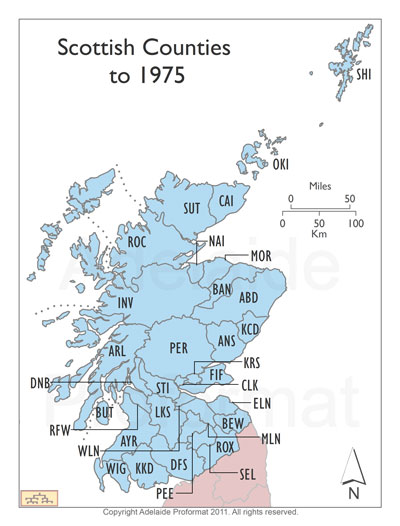Scotland
The Kingdom of Scotland emerged as an independent state in the Early Middle Ages and continued to exist until 1707, although it shared its monarch since James VI of Scotland succeeded to the English and Irish thrones in 1603. On 1 May 1707, Scotland entered into a political union with England to create the United Kingdom of Great Britain.
In the 12th century the office of sheriff was introduced to Scotland and increasingly the office became hereditary. The areas under the jurisdiction of sheriffs were known as shires or sheriffdoms and these were eventually adapted to become the counties of Scotland.
In 1305 Edward I of England issued an Ordinance for the Government of Scotland listing the then 24 shires:
| Aberdeenshire ABD |
Ayrshire AYR |
Banffshire BAN |
Berwickshire BEW |
| Clackmannanshire CLK |
Cromartyshire |
Dumbartonshire DNB |
Dumfries-shire DFS |
| Edinburghshire |
Elgin and Forres |
Fifeshire FIF |
Forfarshire |
| Haddingtonshire |
Inverness INV |
Kincardineshire KCD |
Kinross-shire KRS |
| Lanarkshire LKS |
Linlithgowshire |
Nairnshire NAI |
Peebleshire PEE |
| Perthshire PER |
Selkirkshire SEL |
Stirlingshire STI |
Wigtownshire WIG |
 The remaining shires were formed either by the territorial expansion of the Kingdom or by the subdivision of existing sheriffdoms. Many of the new shires had irregular boundaries or detached parts as a result of the possessions of the heritable sheriffs. The remaining shires were formed either by the territorial expansion of the Kingdom or by the subdivision of existing sheriffdoms. Many of the new shires had irregular boundaries or detached parts as a result of the possessions of the heritable sheriffs.
In older records Kincardineshire may be recorded as the Mearns.
1114: Roxburghshire or Teviotdale [ROX]
1305: Ross-shire formed from part of Argyll in 1503.
1322: Argyllshire [ARL]created as a result of subduing the lordship 1222. Norwegian claims over this area ended 1266.
1369: Kirkcudbrightshire [KKD] formed in area between Rivers Nith and Cree. Granted to Archibald the Grim who appointed a steward to administer the area, hence it became a stewartry and is commonly called the Stewartry of Kirkcudbright, or just the Stewartry.
1388: Buteshire [BUT] formed from part of Kintyre district of Argyll.
1402: Renfrewshire [RFW] separated from Lanark.
1468: Orkney Islands pawned by Christian I of Norway for 50,000 guilders.
1469: Shetland pawned by Christian I of Norway for 8,000 guilders.
1503: Caithness-shire (contigious with the Diocese of Caithness) [CAI] separated from the sheriffdom of Inverness in 1503.
1633: Sutherland [SUT] separated from Inverness.
1685: Cromarty was made a county separate from Ross-shire. With the union of Scotland with England and Wales in 1707, the term county began to be applied to the sheriffdoms.
1889: Edinburghshire renamed Midlothian [MLN].
1889: Ross and Cromarty [ROC] united to form a single county.
1889: Orkney and Shetland were deemed to be two counties.
1890: Orkney Islands [OKI] and lordship of Shetland (Zetland) [SHI] were separated to form counties of those names.
1918: Elgin and Forres renamed Morayshire or the County of Moray [MOR].
1921: Haddingtonshire renamed East Lothian [ELN].
1924: Linlithgowshire renamed West Lothian [WLN].
1928: Forfarshire renamed Angus [ANS].
Cities with county status with monarch who created status— all surviving to 1975 were abolished:
| Town, city, borough |
Monarch |
Co
|
Co town |
Start
|
| Aberdeen |
William IV |
ABD
|
Aberdeen |
1835
|
| Dundee |
William IV |
ANS
|
Dundee |
1835
|
| Edinburgh |
William IV |
MLN
|
Edinburgh |
1835
|
| Glasgow |
William IV |
LKS
|
Glasgow |
1835
|
In 1975 the country structure of Scotland was changed. The place codes used for Scotland are known as Chapman Codes after their innovator, Colin Chapman. These are used by family historians to identify the counties of Scotland prior to 1975.
When seeking information about ancestors, a knowledge of where they lived is paramount to locating records. When researching regions before the start of civil registration this becomes even more significant as the records were generated at the local level. Knowing where the family lived will point you towards the appropriate repositories.
A surprising number of boundaries and borders have changed over the generations and the region the particular place is located in today could be entirely different. This may mean the records sought could be located in unexpected places and therefore a good understanding of borders and boundaries is important.
Apart from boundaries created by civil jurisdictions, a knowledge of the boundaries of ecclesiastical authorities is also significant. This is particularly so in the era prior to the introduction of civil registration when the Established Church maintained what we today would consider a civil function.
 GENUKI (Genealogy UK and Ireland) is a major free resource of information for family history researchers. For detailed information on individual Scottish counties go to GENUKI Scottish pages. GENUKI (Genealogy UK and Ireland) is a major free resource of information for family history researchers. For detailed information on individual Scottish counties go to GENUKI Scottish pages.
|